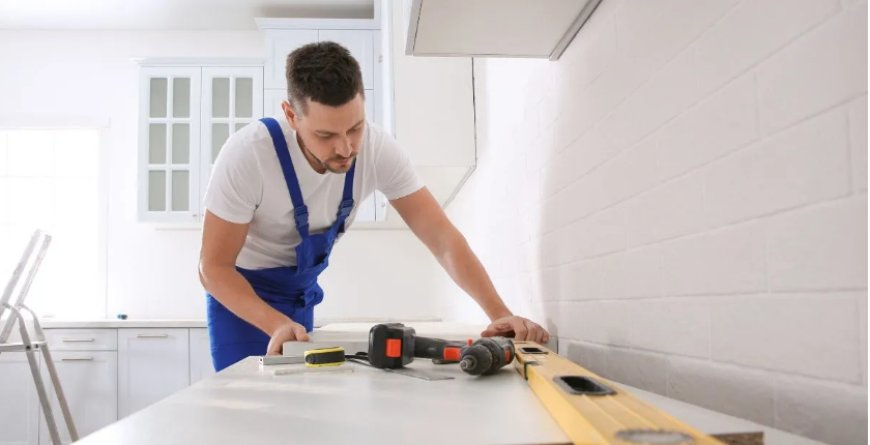Precise Measurements and Templating of Countertops
The following processes are used for precise measurements and templating of countertops:
Accuracy in Measurement
Accurate countertop measurements are the foundation of a successful countertop installation. Precise measurements ensure that the countertop fits perfectly within the space, minimizing the risk of gaps, misalignments, or costly adjustments during installation. Professionals emphasize the importance of accurate countertop measurements to achieve a flawless fit, which ultimately enhances both the functionality and aesthetics of the finished countertop.
Inaccurate measurements can lead to significant issues, such as uneven edges or improper overhangs, which can compromise the overall quality and durability of the countertop. Therefore, investing time and effort into this critical step is essential for a seamless installation.
Templating Techniques
Once accurate measurements are obtained, professionals employ advanced templating techniques to create a precise blueprint for cutting and shaping the countertop. Templating is a crucial step in the countertop templating process that involves creating physical or digital templates that mirror the exact dimensions and contours of the space.
Digital templating, often done with specialized software, allows for precise adjustments and ensures that every curve and edge is accounted for, while physical templates provide a tangible reference for cutting. These templates guide the fabrication process, ensuring that the countertop is cut and shaped to fit the space perfectly, reducing the margin for error, and ensuring a flawless installation.
Cutting and Shaping the Countertop of Countertops
The following are the ways for cutting and shaping the countertop:
Use of Advanced Tools
The cutting and shaping stage is where the countertop material begins to take its final form. Professionals use advanced tools, such as bridge saws and CNC machines, to cut and shape the countertops with high precision. These tools allow for intricate designs and custom cuts, ensuring that every aspect of the countertop meets the specific design requirements. The precision offered by these tools is critical in maintaining the integrity of the material and achieving the desired outcome, whether it’s a complex shape or a standard rectangular slab.
Shaping and Edge Profiling
After the initial cuts are made, professionals focus on shaping and edge profiling to refine the countertop's appearance. Custom edge profiling for countertops adds character and style, with options ranging from simple beveled edges to more intricate designs. The choice of edge profile is not only the countertop’s aesthetic but also its functionality, as certain profiles may be more resistant to chipping or wear. The careful shaping and profiling process ensures that the countertop fits seamlessly into the overall design of the space, enhancing both beauty and utility.
Quality Control and Inspection of Countertops
The quality control and inspection for countertops are mentioned below:
Ongoing Quality Checks
Throughout the countertop fabrication stages, ongoing quality control is essential to ensure that the final product meets high standards. Professionals conduct quality checks at various stages, from initial cutting to final polishing, to catch any defects or inconsistencies early. These checks help maintain the integrity of the material and ensure that every piece of the countertop is flawless before proceeding to the next step.
Final Inspection Before Installation
Before the countertop leaves the fabrication shop, a final inspection is performed to ensure that every detail is perfect. This includes checking the dimensions, edge profiles, surface finish, and overall appearance. The final inspection ensures that the countertop is ready for installation and that it will meet the client’s expectations for quality and craftsmanship.
Seam Placement and Alignment of Countertops
For seam placement and alignment, we used the following process:
Strategic Seam Placement
In projects involving multiple pieces of stone or large countertops, seam placement is a crucial consideration. Professionals strategically place seams to ensure they are both structurally sound and minimally visible. Proper seam placement not only contributes to the countertop’s strength but also enhances its visual appeal by creating a more cohesive look.
Seam Alignment Techniques
During installation, seam alignment is critical to achieving a seamless appearance. Professionals use precise techniques to align seams perfectly, ensuring that they are virtually invisible. This attention to detail is essential in creating a polished, professional finish that enhances the overall quality of the countertop.
Professional Installation of Countertops
For professional installation, we can use these best practices:
Site Preparation
Site preparation is a key step in ensuring a smooth and successful countertop installation. Professionals assess the installation site for any potential issues, such as uneven cabinets or flooring, and make necessary adjustments to create a stable, level surface. Proper preparation helps prevent common installation problems and ensures that the countertop will sit securely in place.
Precision in Installation
During the countertop installation process, professionals use precise techniques to ensure that the countertop is installed level and securely. This includes careful handling of the material, precise placement, and proper anchoring to the base cabinets. The goal is to achieve a flawless fit that not only looks great but also stands up to daily use.
Common Challenges and Professional Solutions
Here are common challenges and professional solutions for countertops:
Dealing with Irregularities
Irregularities such as uneven walls or cabinets can pose challenges during installation. However, experienced professionals are adept at dealing with these challenges by making precise adjustments and using specialized tools to ensure a perfect fit. These proactive measures help to prevent issues that could affect the countertop’s appearance or functionality.
Proactive Problem-Solving
Professionals employ proactive problem-solving strategies to anticipate and address potential issues before they arise. This approach minimizes delays and ensures that the fabrication and installation process proceeds smoothly, resulting in a high-quality finished product.
Conclusion
Countertop fabrication and installation is a complex process that requires precision, skill, and attention to detail. By following best practices, from accurate measurements and templating to careful cutting, shaping, and installation, professionals can ensure that every countertop project is executed flawlessly. Each step in the process, from material selection to seam and joint management, plays a vital role in achieving a seamless and durable result. Whether dealing with granite and quartz countertop processes or custom designs, adhering to these professional standards guarantees a high-quality outcome that enhances the beauty and functionality of any space.


























